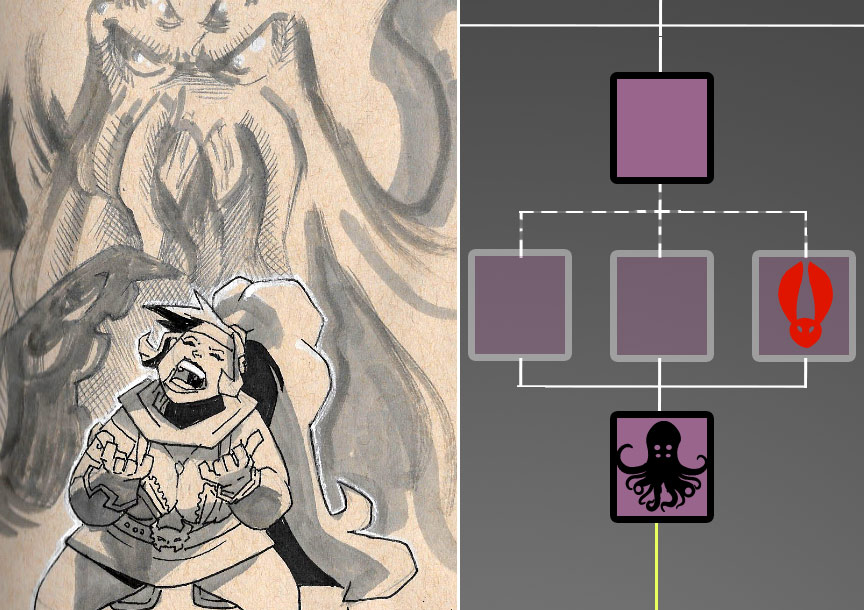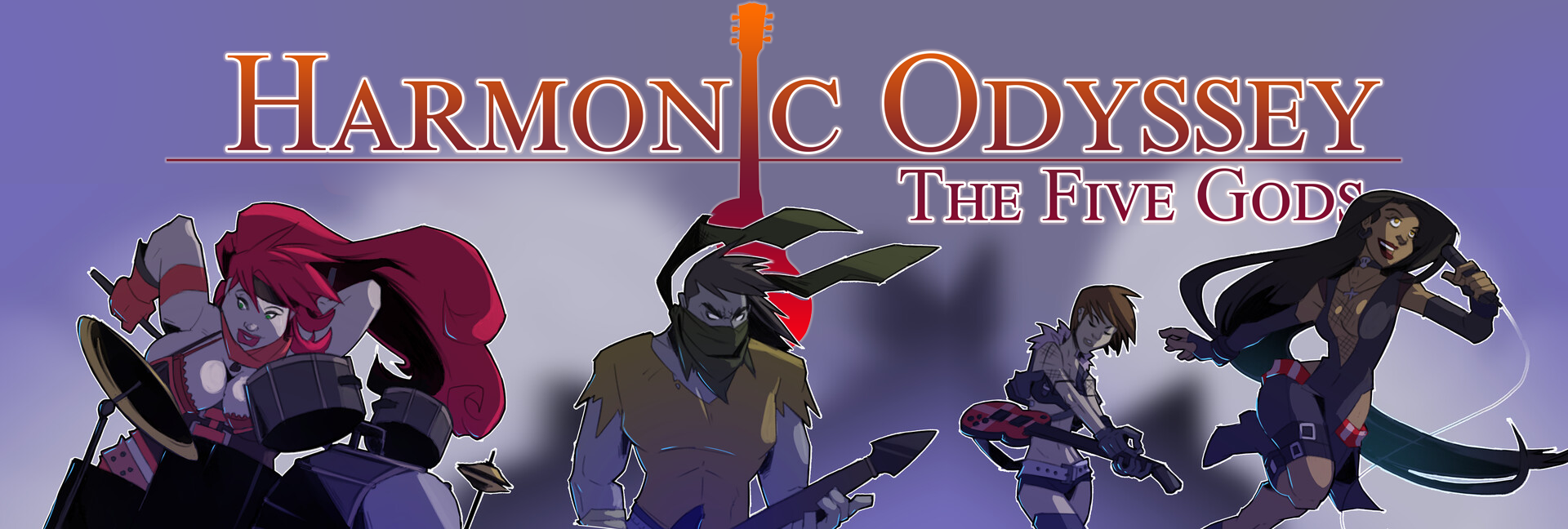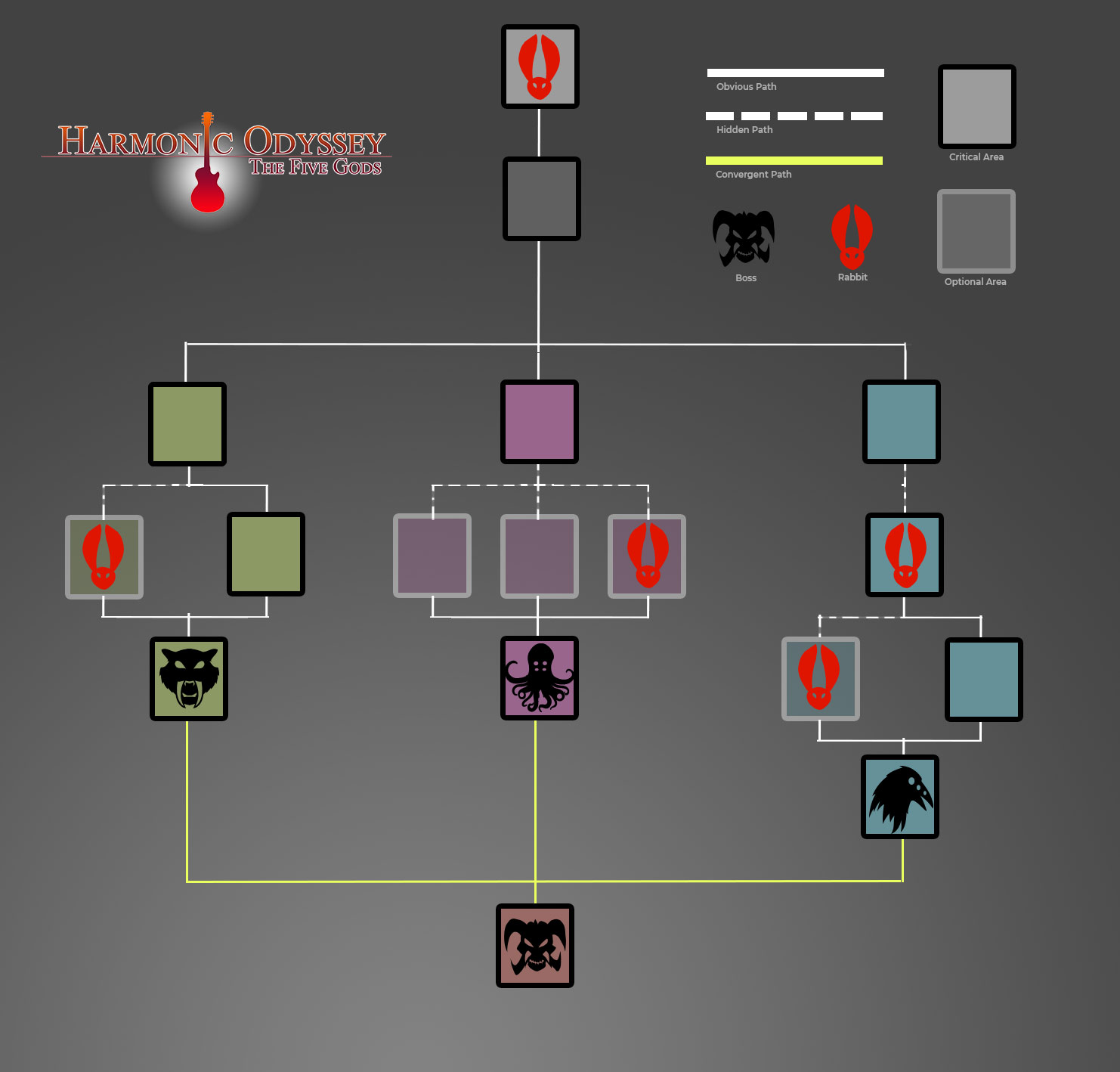Gameplay Layout in Harmonic Odyssey
When I write fiction, I usually start by creating a "skeletal" structure of sorts, when roughing out a first draft. This usually takes the form of condensed chunks of plot being strung together and shifted about until something resembling a complete story emerges. On this Devlog, we've already discussed the generalities of storytelling in a game, making choices and seeing consequences, and even character relationships. This time, we're going to talk about how it all comes together to actually make a game, and the broader scope of it all -- the delicate dance between gameplay and game experience.
I love to write stories that have great impact on my readers' emotions -- what writer doesn't? Game design, and especially the kind that strives to make an RPG with a lot of twists and turns beyond the main pathways, takes this a little further, and puts the audience in the driver's seat. The experience is a little more personal than a book and a little more loose in the way the pages line up. For that reason, it has to be significantly tighter at its core, lest the journey become an endless meander into boredom and confusion.
To that end, I employ a technique for writing games, altogether similar to my approach in writing linear fiction. Behold, Harmonic Odyssey in its entirety, in map-form:
The nice aspect of the above image, is that it takes every major "act" in the game, and splits it out into a roadmap for the developer to follow while she is caught up in doing the much cooler parts of game design, like sketching out maps and creating mobs. The aspect it lacks is a consideration for pacing within the game-- everything is mostly the same size and there's no indication of how many minutes the player will spend in each area, which can vary, wildly. For that, we'll need a more drilled-down map, and one that represents not only major events, but individual tasks within each realm, story pieces to be uncovered, and area to be travelled (including places where the player might get a little or a lot lost). Rest assured -- we'll be doing just that in further installments of this blog.
Regardless of its simplified nature, looking at the map above allows us to analyze the overall "feel" of our game, and the impression it will have on the player as they explore within it, as well as the impression it will leave them with, upon completion.
Reading this plan from top to bottom, we can see that we start out in a singular area (Gray City or, as I sometimes call it, "Act 1") which eventually leads us to a sub-area of that map (The Helicopter, "Act 2") and from there, the world opens up completely (Ouroboro, Yig'Drasil, Aum, "Act 3"). The game allows access to the final boss battle when all of the paths are complete ("Act 4").
At the start, things are generally pretty linear. Not that you couldn't do a little exploring on your own, but the NPCs you meet and the places you visit tend to tell you where to go and what you're to do, next. The helicopter ride and pre-excursion-excursion back into Gray City of Act 2, is also straightforward. These spaces are ideal areas to not only give players clues about what they'll have to do when the paths to the game's final encounters begin disappearing later on, but also serve as choice timeframes to throw in important points in the storyline, which do not change as the game progresses.
The map shifts at the center, when we begin to see multiple branching paths (some of which are hidden) throughout Act 3, as well as distinct "optional" areas we might not find at all. Ouroboro, the green area of the map, is pretty clear about what its expectation of the player is: Go run around and do as you're told. Your path is pretty well carved out for you, but you might find some nifty secrets if you snoop around.

But what about the other two areas? In both, hidden pathways block easy progression from your landing point into the next part of the level. In the case of the confusing eldritch drug-nightmare of Yig'Drasil, the Leviathan boss area is the only critical point on the map. Within the violent technocult of Aum, you won't easily navigate the frozen wastelands, and good luck getting help from the sadistic hedonists that you encounter. In these cases, you will have to do a little exploring and certainly more than your fair share of backtracking, if you want to find your way through.
If you're a fan of Metroid, Castlevania or Zelda games, then you might recognize why a designer would engineer her game in such a way. It's frustrating to come across spaces you know you need to get to without the slightest clue as to how. But it's equally rewarding and satisfying to uncover those secrets.
On the flip side, the player can't miss any one powerup, or key point in the story, or other device that is needed to win. In a game like Harmonic Odyssey, where a lot of your experience in playing, interacting, and even dying is based on your own choices, it's crucial the player making their best guesses about outcomes is secured by the relative safety of not breaking the game in a way that it couldn't be completed. Therefore, any optional areas must be held up on a solid foundation of critical ones.
And what about all those bunny rabbits?
The rabbits are "tokens" of sorts, that lead to much more than just new areas of exploration in each realm, and could be considered ongoing side-quests. That being said, they are absolutely key to unlocking all the content of the final parts of the game, and its "true" ending. Looing at our map, one can assume that the ones appearing in critical areas will be, for the most part, easy to find. Those in optional areas and behind hidden pathways will be harder. Also, they seem to really like hanging out in the Raptor's stage (I wonder why that is?) and since these are "extra" tokens and not required to win, it could be determined that this particular arena will see the player doing a lot of exploring if they want to catch 'em all.

So that about wraps it up until next time, when we go deeper into level development and showcase more of what's coming in Harmonic's third act. See you soon!
Get Harmonic Odyssey: The Five Gods
Harmonic Odyssey: The Five Gods
Choose-Your-Own-Adventure novel meets JRPG in this heavy metal tale of dystopian adventure
| Status | In development |
| Author | evolvgames |
| Genre | Visual Novel, Rhythm, Role Playing |
| Tags | Dystopian, Fantasy, Female Protagonist, JRPG, Music, RPG Maker, Story Rich |
| Languages | English |
More posts
- General Devlog UpdateNov 20, 2022
- Harmonic Odyssey Developments for March/April 2022Apr 25, 2022
- Harmonic Odyssey Developments for February 2022Mar 12, 2022
- Harmonic Odyssey Developments for January 2022Feb 01, 2022
- Harmonic Odyssey Developments for September 2021Oct 04, 2021
- Harmonic Odyssey Developments for August 2021Aug 30, 2021
- Harmonic Odyssey Developments for July 2021Jul 29, 2021
- Harmonic Odyssey Developments for June 2021Jun 29, 2021
- New Cutscene Released for Harmonic OdysseyJun 18, 2021
- Harmonic Odyssey Developments for May 2021May 31, 2021


Leave a comment
Log in with itch.io to leave a comment.